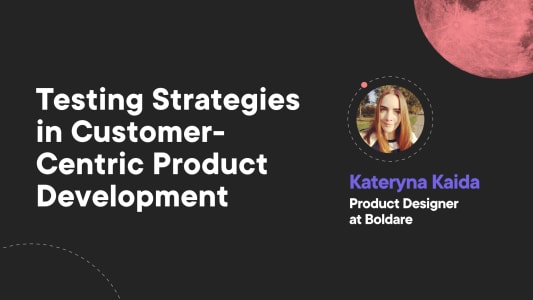The opportunity solutions tree – what it is and how to use it
Excellent digital products come from the opportunities presented by a combination of user needs, market conditions, and technological possibilities. In other words, you need a clear understanding not only of what you’re building but also why. Used as part of the product discovery process, an opportunity solutions tree is a tool that helps to map out the opportunities and plan experimental approaches to solutions. Read on to find out more about the opportunity solutions tree and how we use it at Boldare.

Table of contents
What is an opportunity solutions tree?
An opportunity solutions tree (OST) is a non-linear model that visualizes your product-related goals and opportunities and how they connect to the potential solutions available. According to Teresa Torres, the inventor of OST as a tool, an opportunity solution tree is,
…a simple way of visually representing how you plan to reach the desired outcome. It also helps make implicit assumptions explicit. Opportunity solutions trees help you to navigate opinion battles, frame your decisions as ‘compare and contrast’ rather than ‘whether or not,’ align around a shared understanding, and communicate how you’ll reach the desired outcome.
The opportunity solutions tree template has four sections:
- A clear product outcome.
- The opportunities that can be identified from the research, observations, product data, and the team’s own experience.
- Potential solutions to those opportunities.
- Experiments that explore those solutions.
What exactly is an “opportunity”? An opportunity is a factor that can lead you to achieving your outcome. An OST is a way to visualize potential experiments which will bring you closer to taking advantage of your opportunities.
Benefits of using opportunity solutions tree as part of the product discovery process
Product discovery is a critical process in the development of your digital product. Using an opportunity solutions tree can bring the following benefits to product discovery:
- The development team looks at the problem more widely – An OST stops the team focusing on solutions too early in the process. By looking specifically at opportunities, the team uses a ‘wider lens’ and as a result, often has more potential development directions to choose from.
- Everything links back to the business goal – In an OST, the outcome or business goal is at the top, everything flows from this point. The identified solutions are easy to connect back to the overarching goal. And if they’re not, it’s clear that the discussion has strayed too far from the point. As a consequence, development teams are goal-focused right from the start of the process – they’re not driven by product features, they’re driven by product goals.
- Research and the user perspective are included – With an OST, it is impossible to leap directly from goal to solution; between the goal and any solution, there must be an opportunity. That’s how the model works. It ensures that any solution you take forward is linked directly to a product opportunity.
- It prioritizes your opportunities – Some products and some business goals come with dozens of opportunities. Which ones do you take further?
- You research the right things – Solutions must be validated and explored, and that means research and talking to users (this is the ‘experiment’ part of the opportunity solution tree). Using an OST means your user research is highly focused on specific opportunities and solutions. When you check out your product assumptions, you know you’re verifying the right ones.
Using the opportunity solutions tree – the Boldare way
Our overall goal when using the opportunity tree model is to make better product decisions, based on validated opportunities. We’re also aiming to maintain a high level of transparency and business alignment in the individual project.
There are seven basic stages in the OST process:
- Define the outcome, or business goal.
- Identify key opportunities that might address your business goal.
- Break key opportunities into smaller opportunities, if necessary.
- Identify potential alternative solutions for each opportunity.
- Define experiments to test the solutions.
- Prioritize high-potential opportunities and define clear next steps.
- Iterate.
Before we start, we collect initial user insights (through user research, usability test results, surveys, customer feedback, etc.) and market insights (drawing on known trends, market data, desk research, competition analysis, etc.)
The following steps explain how we use OSTs at Boldare:
Step #1: Define the outcome, or business goal
Choose a product outcome as an aim to achieve. To make it more easily measurable, be as specific as possible. For example:
- To increase the time users spend on the application by 20%.
- To be the #1 shopping app (in nr of downloads) for 16-25-year-old users.
If there are multiple possible goals on the table, prioritize and choose one to focus on (this may be the client’s choice, or a vote by the team, etc.) The outcome or goal should not be solution-based (i.e. the goal itself should not indicate what the solution should be or look like).
Step #2: Identify key opportunities that might address your business goal
Resist identifying potential solutions. This step is about opportunities.
Ideally, opportunities should be something users say about your product, such as:
- 40% of users confirmed they want to watch their favorite shows during the flight.
- 75% of users admitted they would appreciate recommendations of shows similar to their favorites after they finished the last episode.
If research isn’t complete yet, focus on product areas or your business model instead; e.g. “new customer acquisition”, “monetization”, “collaboration with XYZ”, “current user base”, “cost saving”. This can act as a starting point for digging deeper and identifying specific opportunities.
Step #3: Break key opportunities into smaller opportunities if needed
For clarity and transparency, it is useful to group multiple opportunities into categories or break them down into smaller, more specific statements if they are too general.
Step #4: Identify potential alternative solutions for each opportunity
Now is the time for ideation.
For each opportunity, think about alternative solutions, features, or processes that might deliver the required value to users.
Solutions can come from anywhere or anyone – users, stakeholders, product teams, marketing teams, etc.
The golden rule when it comes to the opportunity solution tree is that all potential solutions must link directly to at least one opportunity. Any suggested solutions that don’t link to an opportunity are just distractions from your outcome or business goal.
Step #5: Define experiments to test the solutions
As with any product or feature idea, your potential solutions need testing, especially the assumptions that they may be based on.
Design experiments to test your solutions. These experiments may include further market research or involve user representatives.
Step #6: Prioritize high-potential opportunities and define clear next steps
Once you have your opportunity solutions tree, you need to decide on next steps in order to deliver actual value in line with the outcome or business goal.
Prioritize which opportunities (that’s opportunities not solutions – keep the focus where it belongs) to test first. The criteria is whatever seems appropriate to the project; e.g. percentage of users impacted, time needed to validate, etc.
Step #7: Iterate
Don’t see your OST as a one-off exercise – use it more as an ongoing daily process. Get into the routine of updating it (perhaps as part of regular Scrum events during the project).
Cross out experiments, solutions, or opportunities that turned out to be disproved or invalid. Highlight experiments, solutions, or opportunities that were validated, and develop them further. Add new opportunities or solutions are identified along the way. Modify or adjust the outcome or business goal, if necessary.
In other words, use this process as the basis for multiple iterations of your opportunity solutions tree.
During product development, adopt an approach of ‘continuous discovery’ and refer back to your OST if you:
- Find yourself struggling to prioritize ideas.
- Have a clear outcome or business goal but the ideas are undefined.
- Find you are focused only on one opportunity, one solution, and one experiment at a time.
- Are considering too many opportunities, solutions, and experiments at once.
Organize your product discovery
The opportunity solutions tree works best when discovery is continuous throughout the product development process. By emphasizing opportunities instead of solutions or ideas, an OST helps you focus on what is important: the user’s wants and needs. And at the same time, it keeps everything within the context of the overall business goal. In other words, an OST helps you avoid distractions during product development (the latest shiny idea!) and ensures the team is always working together toward the same outcome.
Share this article:












